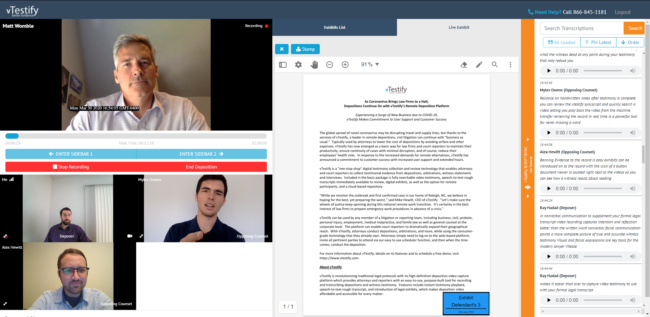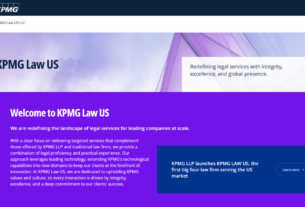It seems that Zoom has become the go-to video conferencing platform for all sorts of uses, and that extends to conducting online depositions and mediations. But why use generic video conferencing software for depositions when there is a product specifically designed for that purpose?
Recently, I was given a demonstration of vTestify, a cloud-based platform designed for conducting depositions remotely. Unlike generic conferencing software, it offers the features, functionality and security that lawyers and court reporters would want in a deposition platform.
These features include high-definition video, exhibit marking and management, synchronized transcripts, real-time testimony transcription and search, private sidebar rooms, and integration with popular trial presentation applications.
The company was a participant in the fall 2017 cohort of the LexisNexis Legal Tech Accelerator and the 2017 Duke Law Tech Lab. It was recently selected by the Texas court reporting firm Goucher Parker Spivey LLC for depositions in multi-jurisdiction asbestos litigation.
The platform is also used for conducting mediations by Resolute Systems, one of the largest ADR providers in the United States.
Last year, vTestify was one of the first seven legal tech companies to join Legal Tech for a Change, a partnership between the American Bar Association and the Legal Services Corporation to provide free technology products and services to legal aid offices that help low-income Americans.
How It Works
During our demonstration, Michael J. Hewitt, vTestify’s president and CEO, told me that the goal in building this platform was to provide the functionality of a live deposition with everyone sitting in the same room.
The platform can accommodate five HD-video participants plus five audio-only participants per recording. In addition, up to 30 others can observe the deposition, but are not recorded. That means you can have participation by the plaintiff and defense attorneys, the witness, the court reporter to authenticate testimony, an exhibit moderator, and others.
In a mediation, which is not recorded, the platform can accommodate up to 10 people on video and four caucus rooms.
Core features of the platform include:
- ScriptSync, a real-time transcription of everything that is being said. Once the deposition is complete, this transcription is synced with the video, allowing the entire video to be searchable using keywords. The company cautions that this feature uses speech-to-text technology that is not perfect and is not a substitute for an official transcript.
- Exhibit management, which enables attorneys to privately upload documents and control which are shared as exhibits, industry-standard timestamping, customizable exhbit stamps, and archiving in a secure cloud repository.
- Advanced layered security that leverages Amazon Web Services (AWS) S3 security protocols, regular security audits, cloud-native video security and redundant audio. Transcripts are produced in a secure, audit-traceable locked environment, and all files are stored in AWS as encrypted files.
- Video sidebar rooms give attorneys and their clients the ability to communicate privately during the deposition process without being recorded. In mediations, these sidebar rooms are used as caucus rooms.
Generally, the court reporter would control the application’s functions during a deposition. Starting the recording is the equivalent of going on the record.
Attorneys can privately upload documents to the platform and then privately view and select which documents to share as exhibits. Once introduced as exhibits on the record, documents are digitally endorsed with the time and data and case details, and the court reporter can apply exhibit stamps. Documents can be annotated by the witness or attorney.
During a deposition, each audio stream is separately recorded. Thus, even if parties speak over each other, the court reporter (or attorney) can listen to each stream independently and get a more-accurate record.
The developers deliberately omitted any chat function. They heard from potential users concern that a chat function could be used by an attorney to coach a witness. Since both the witness and attorney are on video, coaching is not feasible.
At the completion of a deposition, the recording is stored in the cloud and immediately available. Recordings can be exported into standard file types that can be imported into most trial presentation software, including Sanction and TrialDirector.
For security, both the audio and video streams are encrypted end to end and protected by industry standard AES-256 technology, the company says. Files are securely stored on Amazon Web Services.
Although law firms can directly purchase vTestify, most of the company’s customers are court reporting firms. Court reporters can purchase use of the platform on an a la carte basis (by the minute) or in discounted bulk packages.
No question, vTestify is more expensive than a generic video conferencing platform such as Zoom. But for critical depositions that must go on even in the midst of a quarantine, vTestify is the next best thing to being there live — and in some ways it is even better.
“We didn’t build this for COVID-19,” CEO Hewitt told me, “but we’re hearing a lot of lawyers who use it say, ‘Why would I ever travel again for a deposition, why not always do it this way?’”

